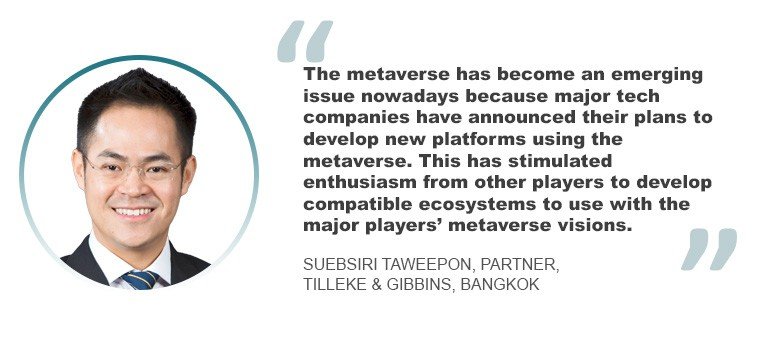IP in the World of the Metaverse
31 March 2022

Metaverse has been a buzzword since the rebranding of Facebook to Meta, and Microsoft announcing the inclusion of virtual avatars and immersive meetings in MS Teams – which is already coming to life in the first half of 2022.
But what is the metaverse, and how does IP come into play? What opportunities and challenges does this present to IP rights, brand owners, and companies, among others?
According to Suebsiri Taweepon, a partner at Tilleke & Gibbins in Bangkok, the definition of “metaverse” can mean limitless imagination. “As of today, and in the near anticipated future, to me, the metaverse is an immersive online experience, which utilizes VR- and AR-related technology and devices,” he says. “Many people think that it will be the next-generation internet or Web 3.0. However, the metaverse is not a new technology – it has been discussed and developed for more than 10 years.”
He adds: “The metaverse has become an emerging issue nowadays because major tech companies such as Meta (formerly Facebook) and Microsoft have announced their plans to develop new platforms using the metaverse, including both for entertainment purposes and for working environment purposes. This has stimulated enthusiasm from other player to develop compatible ecosystems to use with the major players’ metaverse visions in a manner that is increasingly accessible for general users. However, we are yet to see the actual products and services for general users to truly understand this technology. In my opinion, I expect that the industries that will experience an immediate impact are education, finance, games, and entertainment. In addition, I believe cryptocurrencies will be heavily used in the metaverse ecosystem.”

Devices and protecting brand owners
With many factors coming into play in the metaverse, many opportunities are in store, perhaps more so in the technology industry. Taweepon says that one of these is developing AR and VR devices, enhancing the user-friendliness of such devices, making them cheaper and more comfortable for longer use in the metaverse. He says: “There will also be more opportunities for AR technology-related devices to be created for use with a larger variety of items, such as eyewear, or other objects which will make AR/VR more accessible for general users.”
Andreas infringed the real strip club’s logo and exterior design trademark rights. The court ultimately held that the depiction of the strip club in the video game did not infringe the trademark rights as the use of the trademark is not explicitly misleading and the video game was an artistic expression protected by the First Amendment.
Tran says that to guard these assets, it is relevant to take preventive measures such as registering the trademark, subscribing to a trademark watch service, promptly notifying the metaverse platform of alleged infringing acts, or establishing a metaverse presence, among others.
“Brand owners should also take into account the use of technology and protection information in guarding their legitimate rights,” he says. “One possible solution can be to embed signifiers of authenticity into digital items to disincentivize the use and creation of IP-counterfeiting digital goods, as well as to provide the public with the ability to determine the provenance of the goods they encounter. Another avenue is to use NFT technology to embed and establish rights associated with digital content and goods to give parties clarity on what they are entitled to do with the digital products from the very beginning. Informatio that can be provided through metadata in an NFT includes the history of ownership, the scope of rights passing with the ownership of the NFT token, as well as any other relevant and necessary descriptions about the product.”

He adds that it could be quite challenging to enforce IP rights on metaverse-related platforms, as these platforms could be operated via a decentralized autonomous organization (DAO) or a legal entity that is established in some faraway countries.
“In practice, local enforcement authorities may hardly deal with those platforms given their limited jurisdiction and geographic limitations,” he says. “In such cases, brand owners should also consider reviewing the platform’s terms of services that should prescribe what platform users can and cannot do on the platform as well as how the platform will handle infringements of third-party IP.
For example, Decentraland, an open-source 3D virtual world platform where users can create, experience, and monetize their content, encourages the claim-making party to directly contact the infringing party first; in case the parties cannot reach a solution within a period of 30 days from the time informal dispute resolution begins, either party may initiate binding arbitration as the sole mean to resolve claims.”

Monitoring IP in the metaverse
It already takes brand owners significant efforts and resources to monitor the traditional markets (physical markets and e-commerce websites). But is monitoring IP in the metaverse even possible?
“While monitoring the metaverse is not impossible, compared to the traditional market, the efforts and resources required will surely increase by many folds,” says Tran. “There may be countless worlds in the metaverse, and each is unique and vast in content.”
He adds: “Effectively using resources and being creative in taking action are the keys here. Brand owners may want to develop different strategies to monitor their IP assets in the metaverse, such as identifying their core IP assets susceptible to infringement and virtual worlds that IP infringement will likely take place, and even following online chat groups and social media accounts of potential infringers to monitor their moves. As monitoring all IP assets can be of significant burden for metaverse platform providers, they often exempt themselves from the obligation to actively review and take actions against users on their platforms. Hence, a notice-and-takedown mechanism is among their options of preference. As a matter of fact, to activate this mechanism, users, or IP owners, shall act first, and are recommended to, among other things, subscribe to a watch service offered by counsels to keep track of infringement occurring on the platform.”
He adds that while innovative as the metaverse might seem, legal implications associated with such a technological invention are also emerging as a pressing phenomenon.
“To me, what is apparent is that the prevailing laws cannot anticipate all possible scenarios and hence, beg to be amended to reflect new changes introduced by the metaverse, which calls up questions around territoriality, possible expansion of the scope of the traditional IP rights, licensing, the platform’s liability, user-generated content, and virtual enforcement,” he says. “The future of IP will be substantially determined by whether legislators can adapt to this state-of-the-art technological era.”






